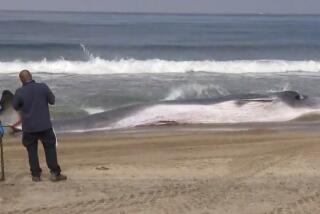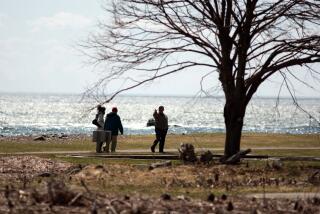Noisy Bid to Rescue Wayward Whale to Be Attempted Today
RIO VISTA, Calif. â Federal officials and volunteers will attempt today to drive a wayward humpback whale out of the Sacramento River and back to sea by herding it with boats and assaulting it with the noise of clanging pipes.
The National Marine Fisheries Service approved an ambitious plan Wednesday to push the 40-foot animal out of shallow Shag Slough and into San Francisco Bay using dozens of vessels and hundreds of people.
The plan could include herding the 45-ton creature with an underwater barrier or dismantling part of a small bridge that seems to be blocking the whaleâs progress downstream.
As a last resort, the fisheries service is even prepared to try to capture the 40-ton whale and haul it out to the Pacific in a barge filled with water, said Jim Lecky, a wildlife biologist with the agency.
The fisheries service, which has jurisdiction over the rare whale, approved the plan after the giant mammalâs condition appeared to deteriorate as it swam in circles in about 15 feet of water in the dead- end slough.
âIf he stays where he is, heâs in a lot of trouble,â Lecky told a press conference called to announce the plan.
The whale entered San Francisco Bay two weeks ago, taking a detour from the humpbacksâ annual migration from Alaskan to Hawaiian waters, and swam steadily north until it reached the slough, about 60 miles from the Pacific.
For the last five days, it has been swimming in a mile-long section of the fresh water channel next to a pasture where cows are peacefully grazing.
Marine biologists, who have observed the leviathan, say it appears to have lost energy and could become ill from prolonged exposure to fresh water.
The first phase of the potentially dangerous rescue plan will involve herding the mammal with five boats down the 100-yard wide slough.
Volunteers from the California Marine Mammal Center will suspend fluid-filled pipes in the water and bang on them with mallets to drive the whale downstream, Lecky said. The method has been used in Japan to drive dolphins back to the ocean.
With any luck, the whale will swim back under a small bridge it crossed on its way up the river. The largest gap between the pilings of the bridge is about 20 feet.
If the whale is unwilling to swim through the narrow opening, several of the pilings will be removed by a local construction company that has volunteered its assistance.
If the humpback--nicknamed âHumphreyâ or âE.T.â by Sacramento River Delta residents--does not respond to the noise, the fisheries service is prepared to employ more annoying electronic sounds and, if necessary, explosive devices, Lecky said.
The agency and volunteers are also attempting to devise a plastic barrier that could be hauled underwater to help herd the animal. Once the whale is driven back into the main channel of the Sacramento, the boats will continue to drive the animal toward the bay and the ocean.
At night, crews will stay with the whale and prevent it from moving back up river by making noise and flashing lights under water, Lecky said.
âIf the methods are successful, the intent is to move it all the way to the bay or even farther into salt water, to keep it out of the river system and make it go back to sea.â said Sheridan Stone, also a wildlife biologist with the fisheries service.
During the herding operation, the public will be prohibited from nearing the site of the operation by land, water or air to prevent extraneous noise from distracting the animal.
If none of the these plans succeed, Lecky said his agency may try to capture the whale, hoist it into a barge filled with water and take it back to the Pacific.
One major obstacle for the whale could be the larger Rio Vista drawbridge. Last week, when the endangered mammal spent several days swimming near this little river town, it repeatedly balked at going back under the bridge. If the boats are able to herd the whale to the bridge, traffic will be halted temporarily to reduce noise that might distract the mammal and prevent it from continuing downstream, officials said.
More to Read
Sign up for Essential California
The most important California stories and recommendations in your inbox every morning.
You may occasionally receive promotional content from the Los Angeles Times.










